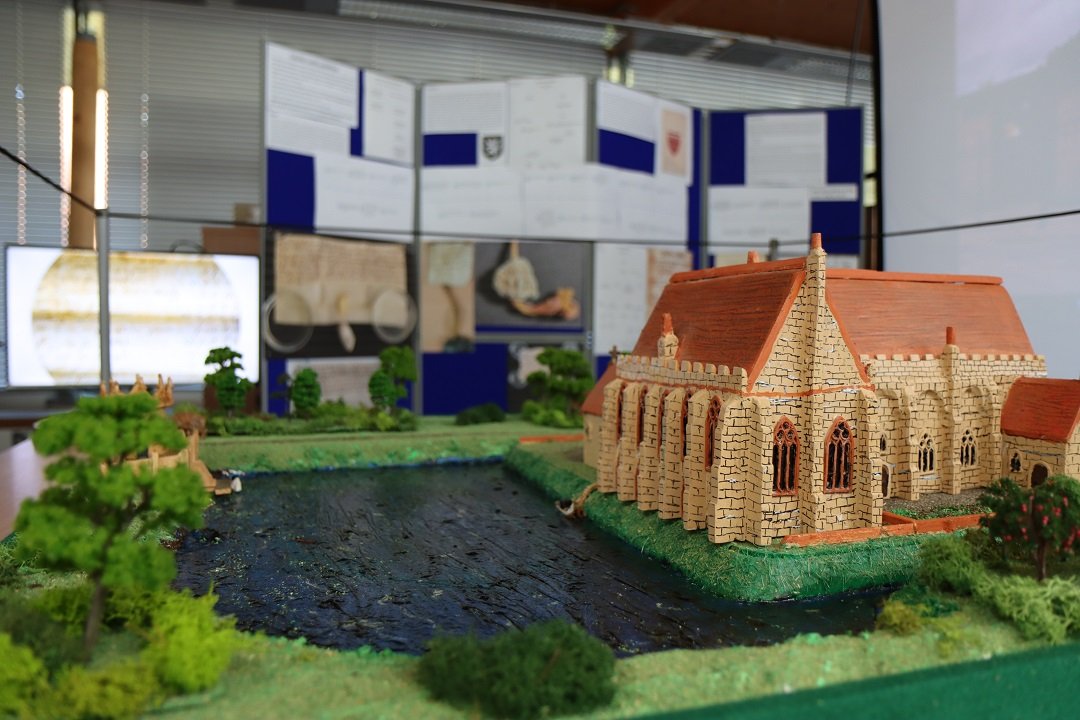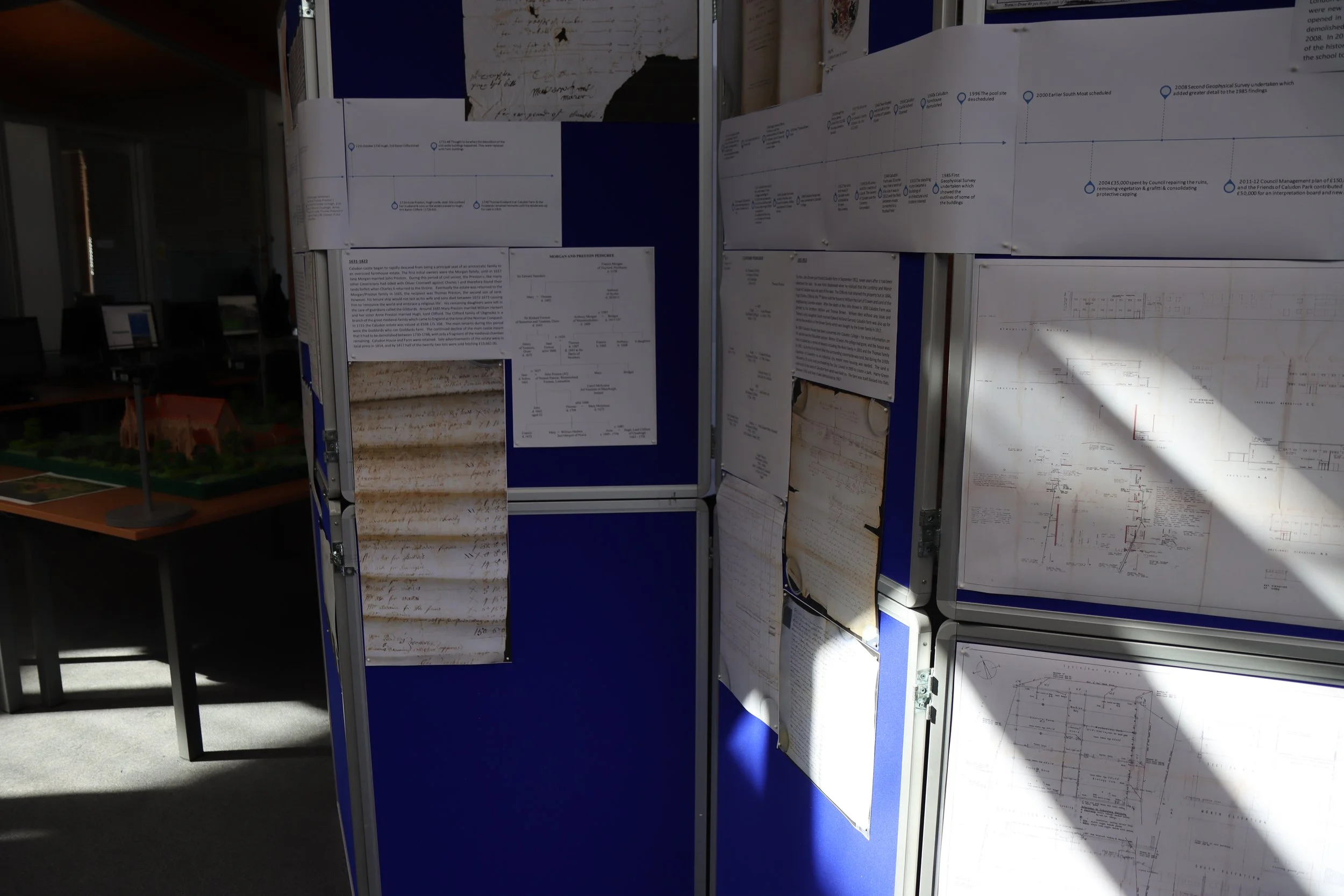
Caludon Castle
Coventry Archives
30 March - 21 May 2022
Caludon Castle in Wyken, Coventry, has a rich tapestry of history going back over 900 years.
The now ruined fortified manor house was once owned by some of the most powerful families in England – the Segraves, Mowbrays and Berkeleys. Connections with royalty and Shakespeare also feature in the colourful history of Caludon which is being brought to life in the first ever dedicated Exhibition on its history.
The Caludon exhibition included an opportunity for the first time to view the historic Caludon Archives, on loan to the History Centre by kind permission of Lord Clifford of Chudleigh whose ancestors were Lords of the Manor of Caludon. These priceless documents go back to the 1200s. Also on display for the first time is a reconstruction of Caludon Castle as it was in the late 16th Century under ownership of the Berkeley family. The reconstructed model of Caludon Castle, created by Peter Garbett, has been loaned to the exhibition by John Clarke OBE who is also the Publisher of the book on the history of Caludon entitled ‘A History of Caludon Castle. The Lords of the Manor of Caludon’.
Origins
The earliest mention of Caludon is in 1150, when it was described as an enclosed deer park, carved out of the wastes, scrub and common grazing land. Prior to the Norman invasion, the land which would encompass Caludon was linked to that well known legend Lady Godiva. After her death in 1067 the land was taken over by Willium Rufus of Warwickshire. During his reign, the manor of Coventry was granted to Hugh d’Avranches, the first Earl of Chester, but then after his death in 1101 the estate transferred to his son Richard. His untimely death on a shipwreck in 1120 saw the land transferred to his cousin Ranulf de Meschines and thereafter his descendants managed the land. This was until c1200 when Ranulf de Blondeville the 6th Earl of Chester granted the estate to Stephen de Seagrave.




Royal Connections
Caludon’s connections with members of the Royal family began early on, with Johann (John) de Segrave being granted a charter in 1305 by Edward I to castellate the Caludon manor house.
During the years that the different families held the park and then the house, various members lost favor with the monarch of the time, which resulted in Caludon castle and park becoming forfeit and held within Royal hands no less than four times between the following periods:
· 1255-1267
· 1405-1413
· 1645-1654
Each time the descendent either managed to purchase it back at a considerable sum or were gifted it back once they had proved their worth to the current Royal household. Many notable interactions in Royal history that have occurred include:
The infamous duel that never took place between John Mowbray V and Henry Bolingbroke on 16 September 1398 at nearby Gosford Green, is immortalized in Shakespeare’s play Richard II. Richard II initially requested the duel to stop the continuous fractiousness between them both, but then stopped it in favor of banishment of both parties. Thereafter the Caludon estate was forfeited to the Royal Household. The estate was eventually granted back to Thomas Mowbray, John Mowbray’s son in 1418, but the Royal household still held a third of the manor’s interest.
In 1476 the last surviving heir of John Mowbray IV was Anne Talbot. At only 5 years old she was betrothed to Prince Richard (aged 4) Son of Edward IV. Both died early though aged 9. Prince Richard was one of the Princes in the Tower whose death remains shrouded in mystery to this day.
Two sons of the Berkeley line had Royal godparents; Henry I had Henry VIII as his godparent and Thomas VI had Elizabeth I as his godmother.
c1200-1494
Stephen de Seagrave was granted Caludon castle and park, by the Earl of Chester in recognition of his support to King Richard and the crusades. This can be roughly dated between 1190-1200. In return Stephen was required to provide a sparrowhawk annually to the king to retain his lands. Stephen Seagrave was intent on creating a park, mainly for hunting. Over time he acquired other neighboring lands to extend the estate. It was also to reflect the status symbol of a man rising above his modest beginnings. The estate remained within the Segrave family until 1349 when it transferred to the Mowbray’s. During this period the estate expanded and turned from just being a hunting park to a family home. The park and estate was lost and regained from members of the Royal family twice during this period due to the current Seagrave’s choosing to side with other Lords against the King at different periods. It was only when Nicholas Seagrave brought back the estate from King Henry II that the remaining line managed to retain Caludon castle and park. When the second John Seagrave died in 1353 his sole heir from his marriage to Margaret was their daughter Elisabeth. She had married John Mowbray in 1349 and so it was that Caludon eventually descended to the Mowbray family.
1359-1494
On 4 February 1359, Sir John de Mowbray (III) was called upon by Edward the Black Prince to do ‘fealty for the manor of Caludon and other lands in the county of Warrewyk’. In other words, he had to swear allegience to Prince Edward. John therefore took part in many battles and crusades on behalf of the King. It was upon his death in December 1369 that his sons, who were too young to take over were initially governed by a ward, this time by their great Aunt Blanche Wake until they came of age. Like the Seagrave’s before them the following Mowbrays, continued to fall in and out of favour with whichever member of the Royal family was on the throne, losing the estate another 2 times. The most notorious period of history that occurred was the duel between John de Mowbray V and Henry Bolingbroke. It was also a period when the estate was attacked from outside sources by William Bagot of Baginton in 1380s and Thomas Malory in 1451. After John Mowbray VII death in 1476, Caludon and the rest of the Mowbray lands were entrusted to Mowbray’s wife Elizabeth Talbot. They had one child, Anne Talbot, but with her death age 9 the Mowbray family passed into extinction and the estate was divided.
1494 – 1631
Following the death of the last Mowbray heir, the estate and lordship of Caludon castle came to the Berkeley family. William Berkeley was the first to eventually hold the estate, having received support from King Edward IV to resolve the tangled heredity problems. So began a more stable and golden age of Caludon castle and park. William remained childless and so upon his death in 1492 his brother Maurice and his wife Isabel managed to retain fifty out of seventy Mowbray manors including Caludon. They had three sons, Maurice VI, Thomas V, James and one daughter Anne. Maurice’s son Thomas VI did more to improve Caludon castle than any other Earl, mostly in part due to his second wife Anne who wanted Caludon to become a real family home. She embarked on several legal battles to take back control of the estate from Thomas Try who had received ownership of the estate from the wife of Maurice VI. From 1579 refurbishment and extension of the property ensued. The continuing line from Thomas VI to Henry I to Thomas VII resulted in important Royal family members becoming godparents. The estate which had previously taken three pages to list by John Smyth’s chronicle in 1583, in one generation had been reduced by a third to pay off immense debts. By 1629, due to the financial predicament that the Berkelys continued to find themselves in, they had to sell the Caludon estate to Thomas Morgan of Heyford in Northamptonshire.
1631-1822
Caludon castle began to rapidly descend from being a principal seat of an aristocratic family to an oversized farmhouse estate. The first initial owners were the Morgan family, until in 1637 Jane Morgan married John Preston. During this period of civil unrest, the Prestons, like many other Coventrians had sided with Oliver Cromwell against Charles I and therefore found their lands forfeit when Charles II returned to the throne. Eventually the estate was returned to the Morgan/Preston family in 1665, the recipient was Thomas Preston, the second son of Jane. However, his tenure ship would not last as his wife and sons died between 1672-1673 causing him to ‘renounce the world and embrace a religious life’. His remaining daughters were left in the care of guardians called the Gibbards. Around 1685 Mary Preston married William Herbert and her sister Anne Preston married Hugh, Lord Clifford. The Clifford family of Ubgrooke is a branch of the great medieval family which came to England at the time of the Norman Conquest. In 1715 the Caludon estate was valued at £598 17s 10d. The main tenants during this period were the Goddards who ran Goddards farm. The continued decline of the main castle meant that it had to be demolished between 1730-1748, with only a fragment of the medieval chamber remaining. Caludon House and Farm were retained. Sale advertisements of the estate were in local press in 1814, and by 1817 half of the twenty-two lots were sold fetching £13,662.00.
1822-2013
The Rev. John Brown purchased Caludon farm in September 1822, seven years after it had been advertised for sale. He was most displeased when he realised that the Lordship and Manor house of Caludon was not part of the deal. The Cliffords had retained this property but in 1846, Hugh Charles Clifford, the 7thBaron sold the house to William the Earl of Craven and Lord of the neighbouring Coombe estate. After the death of Rev John Brown in 1850 Caludon Farm was granted to his brothers William and Thomas Brown. William died without any issue and Thomas’s only daughter Sarah married Edward Holland Garrard. Caludon farm was also up for sale by descendants of the Brown family which was bought by the Green family in 1917.
By 1880 Caludon House had been converted into Caludon College – for more information on this period see the Education section. Within 10 years the college had gone, and the house was then occupied by a series of tenants including the Aviss family in 1891 and the Thomas family by 1901. Up to the First World War the surrounding countryside was rural, but during the 1930s expansion of Coventry as an industrial city meant more housing was needed. The land is reduced to 20 acres and purchased by the City Council in 1939 to create a park. Harry Green sold much of the land of Caludon farm which was built on. The farm was itself divided into flats between 1950 and then it was demolished by 1967.
Education and Caludon
Caludon College was based within Caludon House in 1880, run by Anton[y] Beaumont. He was also master of Binley Church of England School which had been established by the Earl of Craven in 1839. In 1881 the census records Anton[y], his wife Elizabeth and six pupils. Caludon College was a ‘gentleman’s boarding school’ with pupils ranging from 11-14 who had come from as far as London and Lincoln. It is not known exactly how long the school functioned, but by the 1891 census there were new tenants of the Aviss family. Caludon Castle school was built on part of the former estate and opened in 1954 with places for 1,150 boy pupils. In 2008 the new school was opened after being virtually rebuilt at a cost of £24 million and then became an academy in 2013. The inclusion of the history Caludon Castle and its manor in the school curriculum in 2010 was a significant step for the school to make, introducing local history and archaeology into the classroom.


